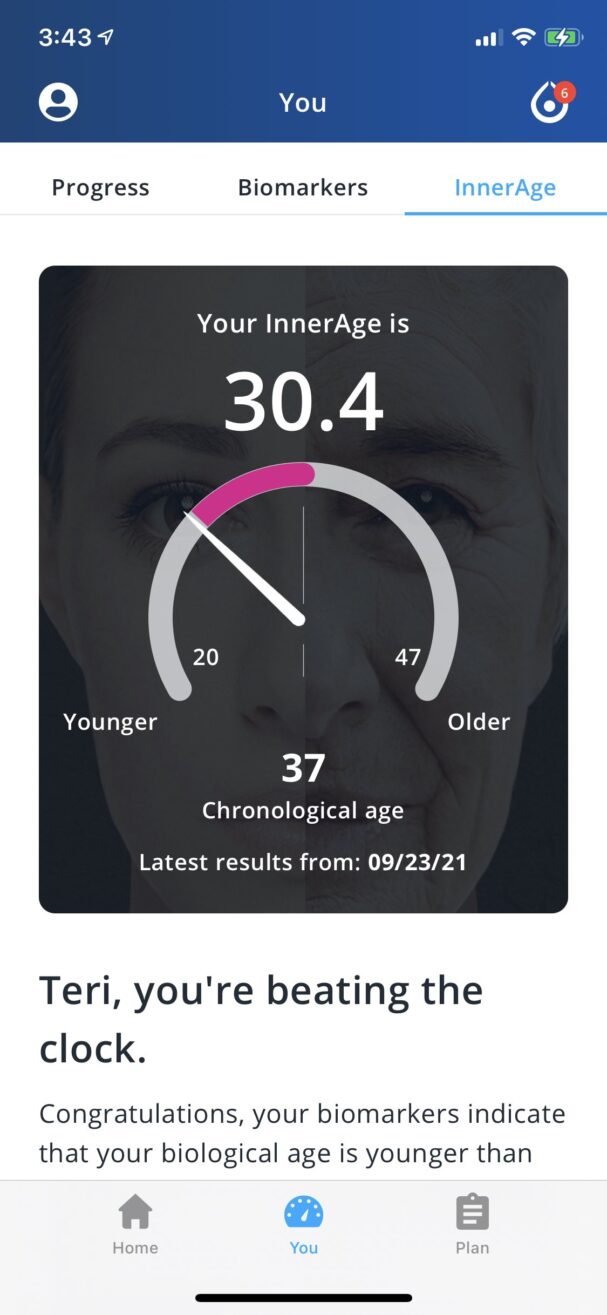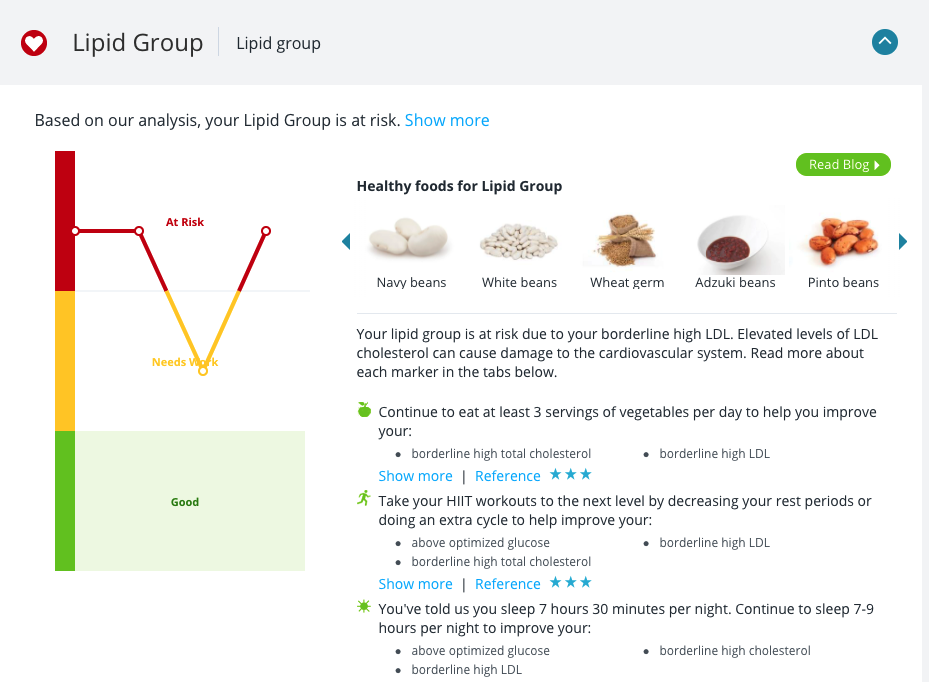

For the 14 years that I worked in Corporate America, I had mandatory bloodwork every year as part of my health insurance. And while I would get the blood test results back and maybe pay attention a little bit, I never felt like I had a super actionable plan to improve things that were not ideal.
When I first heard about InsideTracker years ago through a friend I followed on Instagram, I was immediately interested since the service not only analyzes your blood levels, but also gives you specific recommendations for nutrition, exercise and lifestyle on what to improve as it relates to your health and fitness. And most of the recommendations are dietary based., e.g. tweaking your food intake rather than taking a pill, which I love. Yes, pills are sometimes necessary but if I can fix things with food, I always pick that approach first.
I’ve been using InsideTracker for over 5 years now. I get regular bloodwork a few times a year (more often when I was training for marathons!), and I’m always excited to see what it says. It’s really neat (and helpful!) to have a few years worth of data to look at now (I’m a data junkie if you can’t tell), and see how my health has changed over time. Since so many of us are thinking about ways to practically improve our health as we look toward the new year, I thought I’d re-share this post along with a promo code for anyone who’s looking to try InsideTracker for the first time.
In the post below, I’m sharing some of my personal bloodwork results from InsideTracker and recommendations they gave me to help optimize my not-so-great levels. I’m currently pregnant with our second baby (due in a few months), so my most recent bloodwork was a little wonky. I didn’t share those numbers since the data is likely skewed from pregnancy.
InsideTracker is a blood and DNA testing service that tracks your bloodwork and biometric markers over time. The InsideTracker team is made up of experts in aging, genetics and biometric, who hail from places like from Harvard, MIT and Tufts. The InsideTracker test measures your white blood cell count and then tells you if it’s in the optimal zone. It’s far more comprehensive than the standard bloodwork you get at the doctor. And even analyzes things like your calcium levels.
They use science to drive the recommendations that are personalized to your results. And, they continually add recommendations to the InsideTracker dashboard based on new research.
Ideally, it’s a series of tests you have done you have done to identify trends. They recommend having bloodwork done a few times a year so you can compare your results and track progress on 48 biomarkers, especially as you age, have major life changes, or change your training load.
It doesn’t replace medical advice of course, but rather they encourage follow-ups with your doctor and use your InsideTracker results as part of your overall medical/health plan. And, I have used my InsideTracker results to facilitate lots of conversations with doctors over the years and all of them noted how helpful it was, especially to see trends.
You purchase a plan online from InsideTracker (I always do Ultimate + InnerAge), schedule an appointment at a local lab (I go to Quest), print off the paperwork InsideTracker sends you, go get your blood drawn at the lab and they send the results to InsideTracker. When you purchase your plan, they guide you through everything.
The blood draw itself is very simple. They only prick you once, and then they are able to collect all of the samples they need from there.
Once my bloodwork was analyzed (mine took a few days), I received an email with a link to a personalized dashboard that has SO MUCH INFORMATION. But, they break it down so it’s easy to digest and easy to take action.
The Ultimate Plan tests up to 48 blood biomarkers. This includes things like your glucose, cholesterol, cortisol, and hemoglobin (among many others). They most recently added hormone markers too!
The action plan includes recommended foods to eat, lifestyle changes, supplement recommendations and/or changes to your training and daily activities. The website has really comprehensive information. And you can also see everything at a glance on InsideTrackers’ app, which is handy.
As a reminder, I’m sharing results from a previous year! Since I’m pregnant right now, my current bloodwork isn’t a great example.
Results are broken down by At Risk, Needs Improvement and Optimal.


One thing I especially love about InsideTracker is all the charts. It makes it easy to identify trends or sudden changes. I also find the visual cue helpful and motivating! The screenshots below that don’t have charts were from my first results. You’ll notice as more results are added, trend lines are added to the charts.
Two specific biomarkers flagged as at-risk — Lipids/Cholesterol — didn’t surprise me. But served as another good reminder to pay attention to my diet knowing those are biomarkers I’ve struggled with for years.
High cholesterol is something I’ve had to manage most of my adult life. I was first told that I had high cholesterol when I had bloodwork done at my first job, at Goldman Sachs, when I was 21. I’ve kept an eye on it ever since. And it’s always been borderline high when I’ve had annual bloodwork. And usually my good cholesterol was enough to offset it. But, my first test showed it had gotten even worse.
Here’s my first Cholesterol report in 2019.

In March 2021, my cholesterol and lipids improved. And that was while breastfeeding my first son, which can often cause elevated lipids and cholesterol.
But, you can see in my October 2021 bloodwork that my cholesterol elevated again, dangit! I stopped eating as many oats in the summer and switched to smoothies. I wonder if that really could have impacted it that much! Easy solution: add oats to smoothies!

For reference on the details with at-a-glance info, the screenshots above are from the website and the one below is from InsideTracker’s app. To improve your overall health and specific biomarkers, they provide a food list and other things to incorporate, which is helpful.


Again, the website is more comprehensive and the food lists are a bit easier to see on the website vs. the app.

But, you can set reminders in the app to check-in if you do well with that kind of accountability.

Beyond cholesterol, there have consistently been a few biomarkers I need to keep an eye on, like low ferritin, low sodium and high cortisol.
Female endurance athletes commonly have low iron so I wasn’t too surprised by this. But, I take an iron supplement nearly daily so I appreciated the food recommendations to help increase my ferritin levels. I already eat loads of dark chocolate and peanut butter… not a problem to eat more.
You can see how my Ferritin has struggled to improve over time, even though I take iron (and I don’t take it at breakfast since coffee can interfere with absorption) and incorporate iron rich foods into my diet. I now take 325mg of ferrous sulfate with a glass of water, every other day to increase absorption. I take it in the afternoon so my coffee doesn’t interfere and I take it separately from my multivitamin.

This was interesting to me because I am ALWAYS thirsty, even though I stay hydrated all day and drink a ton of water. However, what I learned was that drinking a ton of water, especially right before a blood test, can be the reason sodium comes back low. I’ve been trying to be better about including sodium in my diet, since I don’t eat a lot of packaged foods which is where most people get too much sodium.
I’ve particularly been working to take in sodium during and after long workouts and it seems to have helped. I don’t really love sports drinks but they contain sodium and other electrolytes, which are critical during long workouts and after any sweaty workout. LMNT is my very favorite brand of electrolytes.
I mean, I knew I had a lot of stress (cough, read this post where I talked about working 80 hours a week at the time) but it was a little jarring to see my bloodwork reflecting that too. They say stress is the silent killer…these results made it a little less silent.
Elevated cortisol can also be connected to running injuries and I was struggling with a few for years — plantar fasciitis, torn posterior tibial tendon, quad strain, sheesh. My stress was elevated, but that wasn’t surprising since I had a rough postpartum period and I’m a working mom. However, studies really do show that mindfulness can improve cortisol so I have a goal to meditate 3-4x a week, if only for 10 minutes. (I use the Peloton app for their meditation classes.)

My platelets also came back VERY elevated. I had just gotten over a cold so it’s possible it was elevated for that reason. But, I contacted my doctor about it and we re-tested just to be sure. It came back normal, phew. But, elevated platelets can be quite serious, and I’m grateful for a service like InsideTracker that can help me catch things if they are indeed an issue.
I prefer the website over InsideTracker’s app. I like LOTS of information but if you just want high-level reminders, the app is great. The website also has recipes and helpful articles from registered dietitians, M.D.s and other health experts. You can read articles such as “Should I take a multivitamin?” and “Optimize Your Microbiome” and “I went Vegan Keto. Here’s what happened to my body.”
So, take your results to your doctor. Ask your doctor to spend time with the results and discuss it together. YOU are your best advocate for your health. So, make sure your questions are answered in a clear manner that you understand.
InsideTracker offers multiple plans, starting at $149 and going up to $699.00. I do the Ultimate test and InnerAge 2.0. Use this link and code TERILYN at checkout for 20% off an InsideTracker plan.
Here are all the options:
They also have a few bundled options which are great if you know you’ll want more than one test.
InsideTracker would make an amazing gift this holiday season. I’ve gifted it to my mom and three of my brothers and they all loved it.
Absolutely. While InsideTracker has given me complimentary tests over the last few years, it’s a service I’ve recommended to family and friends. (My mom has used it too!) And I’d pay for it myself too.
Use this link and code TERILYN at checkout for 20% off an InsideTracker plan.


Notifications
Leave a Comment
7 responses to “My InsideTracker Review after using it for 5 years”
This is so interesting, I definitely will have to check it out- thank you for sharing! I am a genetic counselor & with elevated cholesterol at such a young age, for someone so healthy, I’d be nervous about a family history of familial hypercholesterolemia. (FH gene) Sometimes carriers have elevated cholesterol and even have heart problems/ heart attacks in their 50s-60s. I’m not sure your family history but couldn’t hurt to ask your doctor about it!
I do have a family history of high cholesterol and my grandfather had a heart attack in his 60s. I’ll be sure to talk to my doctor about that. Thank you so much!!! I find genetics fascinating, especially since my mom’s side of my family (and all of my brothers) have so many autoimmune disorders – alopecia, type 1, addison’s disease, crohns, lupus, celiac, the list goes on. What happened to our genes?!!
Thanks for all the information. Just an FYI on the higher cholesterol, it isn’t always dietary related. Besides hereditary factors it can be a sign of undereating, often seen in those with eating disorders. Obviously I’m not implying that is this the case for you, but I do think a lot of people in the running community suffer from disordered eating habits, so just wanted to put a quick note in here.
Thank you for your comment!! A dietitian analyzed my food log (the post is linked below) and he also indicated that I was under eating but I had no idea that could be tied to high cholesterol. I DO have a history of disordered eating, although I don’t feel it’s something I currently struggle with (my under-eating is more related to just not being hungry/gut problems vs. emotional like it was in the past) but I so appreciate you bringing it up because I agree it’s very prevalent in the running community. <3
Could you elaborate on that?? I’ve never heard of that. I realize I was undereating for multiple months while ironman training. My cholesterol went up (but I have a strong fam history like Teri. It’s virtually inevitable they’ll want to put me on statins at 50 but I refuse so ?). Any sources? Thanks. I no longer look at weight as an indicator of health/being in shape.
Again, I am no expert, but this is what I have learned/read throughout my own health journey. Here are a couple of articles and studies, but there are many more. Even if you are eating well and what you think may be balanced, it may not be enough for your body/training. That was the case for me, but obviously do you own research and evaluate your own health individually. Hope this helps!
https://www.medhelp.org/heart-disease/articles/Study-Finds-Male-Marathon-Runners-Have-Increased-Coronary-Plaque-Buildup/1174?page=2
https://www.promisesbehavioralhealth.com/addiction-recovery-blog/high-cholesterol-in-anorexics/
https://pubmed.ncbi.nlm.nih.gov/16459892/
Hello and thanks for the Inside Tracker code! It worked perfectly. Lovely site, cheers